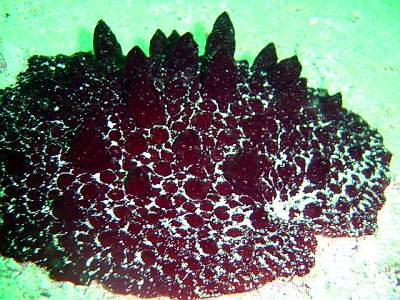
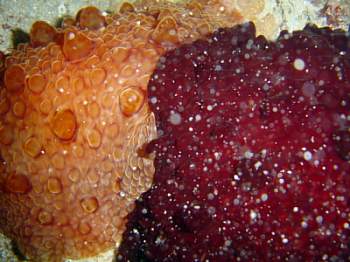
Pleurobranchus hilli
(Hedley, 1894)
Order: NOTASPIDEA
Superfamily: PLEUROBRANCHOIDEA
Family: Pleurobranchidae
DISTRIBUTION
South eastern Australia from central New South Wales, to Tasmania, Victoria and South Australia.
PHOTO
Jervis Bay, 5 - 15 m, on sand. February 2002. Length - 'more than 30 cm'. Photos: Sue Newson
A large pleurobranch growing to more than 30 cm in length. Usually a deep purplish brown colour, but sometimes quite a pale brown. Not usually found intertidally, but not uncommon in sheltered bays where it is usually found on sandy bottoms, where it can partially bury itself in the sand. The mantle is covered in rounded and pointed papillae. The pointed papillae are sometimes quite large.
-
Hedley, C. (1894) On some naked Australian marine Mollusa, Part 1. Proceedings of the Linnean Society, NSW, 12(9): 126-128.
-
Thompson, T.E. (1970) Eastern Australian Pleurobranchomorpha (Gastropoda, Opisthobranchia). Journal of Zoology, London, 160: 173-198.
Rudman, W.B., 2003 (April 13) Pleurobranchus hilli (Hedley, 1894). [In] Sea Slug Forum. Australian Museum, Sydney. Available from http://www.seaslugforum.net/find/pleuhill
Related messages
Pleurobranchus hilli from South Australia
April 9, 2007
From: Alexius Sutandio
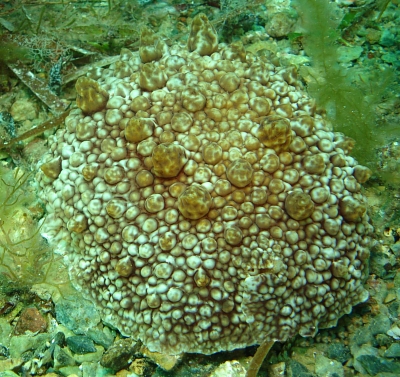
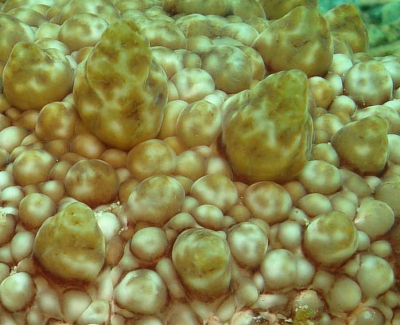
Hello,
I just curious about this species. I already send this picture to Reefwatch and got information that the pictures are of a side gilled slug (pleurobranch). A bit like a giant nudibranch. But I need more information a little bit further about this species if available.
I took this pictures under Rapid Bay jetty on 31st December 2006 last
year. Depth 7.4 metres. Time 14.32 pm. Diameter about 20 cm. Water temperatures 17 degrees Celcius.
Locality: Under Rapid Bay Jetty, 7.4 metres, South Australia, Australia, Yankalilla Bay, 31 December 2006, Gravel bottom.. Length: 20 cm diameter. Photographer: Alexius Sutandio.
Thank you!
Regards,
Alexius Sutandio
axes23@yahoo.com
Sutandio, A., 2007 (Apr 9) Pleurobranchus hilli from South Australia. [Message in] Sea Slug Forum. Australian Museum, Sydney. Available from http://www.seaslugforum.net/find/19707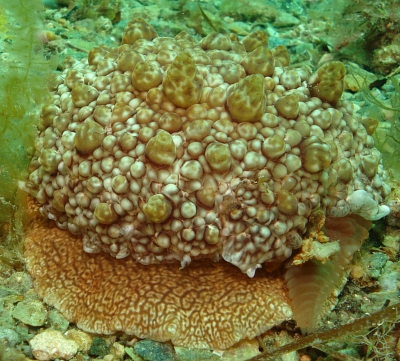
Dear Alex,
This is indeed a side-gilled slug. In the photo alongside, you can see a brownish feather-like structure on the right, between the warty top of the animal and the foot. That is the pleurobranch gill which gives this group their name. Most species have a single gill on the right side of the body. Your animal, Pleurobranchus hilli, can grow to about 30 or 40 cm in length and is found in southern Australia from New South Wales around to South Australia and Western Australia. Have a look at the species Fact Sheet and the accompanying messages for more information and photos.
Best wishes,
Bill Rudman
Giant Slug from Coffin Bay, South Australia
August 31, 2006
From: Mark Hood
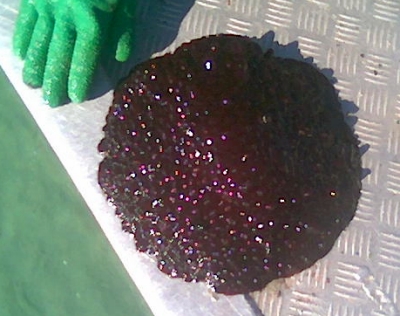
Can someone shed some light on the most amazing slug I have ever seen!
It is huge, 300 mm plus across, Domed top with nobs of differing sizes protuding up from dome. Weight about 2 kg. Deep maroon almost purple in colour. May have had gills in between the "foot" and the dome
Locality: Coffin Bay, 6 feet, South Australia, Southern ocean, 28 August 2006, Sand bottom in oyster lease. Length: 300 mm
Mark Hood
hood1@bigpond.com
Hood,M, 2006 (Aug 31) Giant Slug from Coffin Bay, South Australia . [Message in] Sea Slug Forum. Australian Museum, Sydney. Available from http://www.seaslugforum.net/find/17655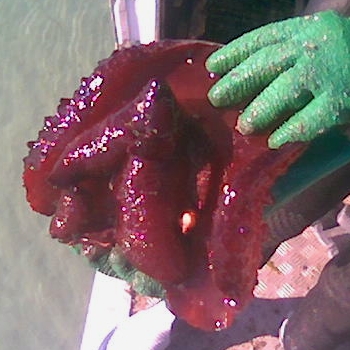
Dear Mark,
This is a pleurobranch or side-gilled slug called Pleurobranchus hilli. At present it has been recorded from temperate southern and south-eastern Australia.
As you can see in your lower photo, it certainly has a large gill along the right side of the body between the foot and the mantle - which is why this group are often called the side-gilled slugs. The white blob alongside the gill is part of the reproductive organs which open alongside the gill. There are not that many records of this species, but is seems to be quite common at times in sandy subtidal locations. Have a look at the other messages about this species attached to the Fact Sheet.
Best wishes,
Bill Rudman
First Pleurobranchus hilli from Western Australia
November 2, 2005
From: Chris Cunnold
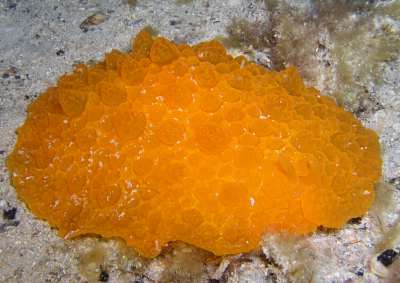
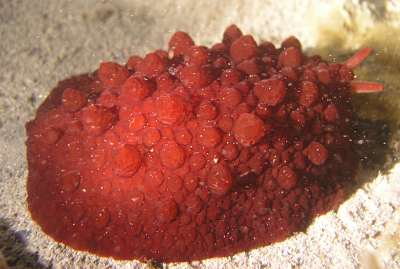
Dear Bill,
I have seen these on several occasions at night at his site now. As well as the two colour varations pictured I have seen them a much darker maroon colour (almost black) and also pink. Are they Pleurobranchus peroni? The size of these ones makes me doubtful as references to them describe them less than half the size of these.
Locality: Cockburn Sound, southern Western.Australia. Indian Ocean. Depth: 6 m. Length: 200 mm. 3 October 2004. rock/rubble/sand . Photographer: Chris Cunnold
Regards,
Chris
cunnold@iinet.net.au
Cunnold, C., 2005 (Nov 2) First Pleurobranchus hilli from Western Australia. [Message in] Sea Slug Forum. Australian Museum, Sydney. Available from http://www.seaslugforum.net/find/15152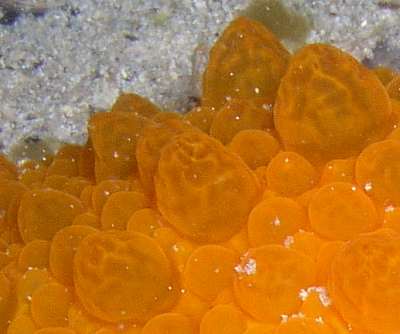
Dear Chris,
They are almost certainly Pleurobranchus hilli, which is a large species growing to about twice the size of your animals. The shape of the papillae and the range in colour fit that species. It is a valuable observation, because I am pretty sure this species has only been reported from New South Wales, Victoria and South Australia previously. It is therefore not surprising to find it in south-western Australia, but nice to have some proof.
Best wishes,
Bill Rudman
Large Pleurobranchus from Victoria, Australia
February 28, 2005
From: Matthew Skinner
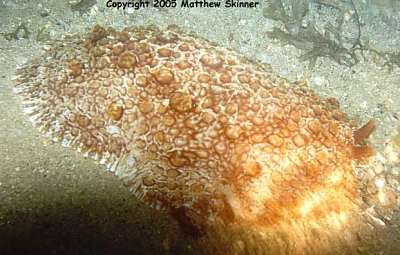
I took this photo in Port Phillip Bay in Feb 2005 and dont know what it is, can anyone help ? It was around 40 cm long and 10 cm high. I have pics with a diver in the photo to help prove the size as the thing was the largest sea slug I have seen.
Locality: Port Phillip Bay, Melbourne, Victoria, Australia. Depth: 4 meters.
Length: 400 mm. 24 Feb 2005. Photographer: Matthew Skinner
Matthew Skinner
skinah@optushome.com.au
Skinner, M., 2005 (Feb 28) Large Pleurobranchus from Victoria, Australia. [Message in] Sea Slug Forum. Australian Museum, Sydney. Available from http://www.seaslugforum.net/find/13241Dear Matthew,
This is indeed a large sea slug. It is Pleurobranchus hilli, a large 'pleurobranch' slug, often called a 'side-gilled slug' because they have one large gill on the right side of the body. You can't see it in your photo because it is hidden under the flap of skin that extends out from each side of the back. Have a look at photos in some of the other messages concerning this species for a photo showing the gill. Certainly at 40 cm, your animal must be reaching a record length. Unfortunately there is no 'official list' of biggest and heaviest sea slugs.
Best wishes,
Bill Rudman
Pleurobranchus hilli from Victoria, Australia
January 10, 2004
From: Harry Thorman
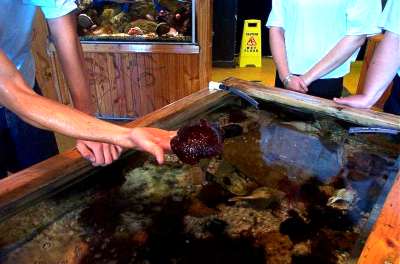
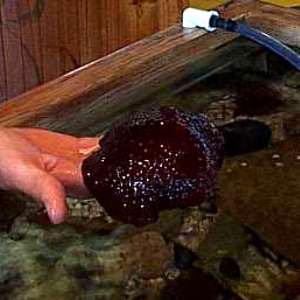
Hi Bill.
I wonder if you might identify a magnificent crimson sea slug. It was brought to the marine centre from a member of the public and it has obviously been collected here at Queenscliff, Victoria. Attached are some poor images revealing a palm sized mollusc. On the underside appears to be a gill structure and another opening with fibrous white tusk like protuberance. I apologise for the image, our photographer is on leave.
Harry Thorman
harry.thorman@dpi.vic.gov.au
Thorman, H., 2004 (Jan 10) Pleurobranchus hilli from Victoria, Australia. [Message in] Sea Slug Forum. Australian Museum, Sydney. Available from http://www.seaslugforum.net/find/11852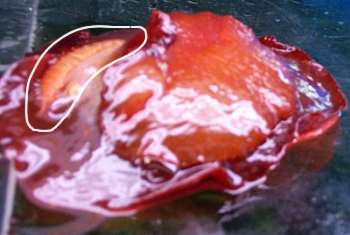
Dear Harry,
This is a large pleurobranch, which are a group of sea slugs commonly called side-gilled slugs because of the large gill they have on the right side of the body under the mantle. I have ringed it in the photo alongside. The 'tusk-like' structure you describe is the penial papillae, which often protrudes when the animal is dying.
From the size and colour I suspect your animal is Pleurobranchus hilli.
Best wishes
Bill Rudman
Pleurobranchus hilli laying eggs
May 23, 2003
From: Leanne and David Atkinson
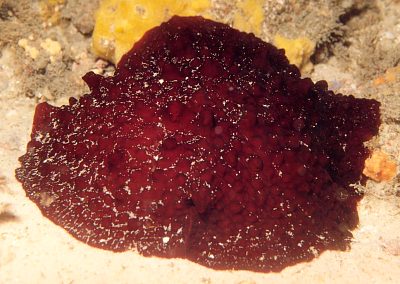
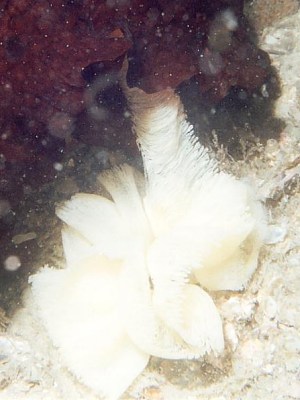
Dear Bill,
After reading recent correspondence about Pleurobranchus hilli we thought we would send in the following photos. Are they Pleurobranchus hilli? Sorry about the scatter in the egg laying picture the viz was very poor and they are such a large subject.
Upper Photo: The Pipeline, Port Stephens, NSW, Australia. Depth: 14m. Night dive on the high tide. January 2002.
Water Temp: 19deg celcius
Lower Photo: The Pipeline, Port Stephens NSW Australia. Depth: 16m. Night dive on the high tide. 10 November 2002
Water Temp: 18deg celcius
Cheers,
Leanne and David Atkinson
atk@hunterlink.net.au
Atkinson, L. & D., 2003 (May 23) Pleurobranchus hilli laying eggs. [Message in] Sea Slug Forum. Australian Museum, Sydney. Available from http://www.seaslugforum.net/find/9820Thanks Leanne and David,
Yes this is P. hilli.
Bill Rudman
Re: Pleurobranchus hilli - feeding observation
April 25, 2003
From: Sue Newson
Sorry Bill,
Concerning your comments. I wish I could say that it was actually taking a bite, but I can't.
However, the positioning of the pleurobranch and the 'food source', the shape of the pleurobranch and the shape of the 'bite' marks, and the 'freshness' of them, could lead me to believe nothing else. I don't know for sure if it is a sponge or an acidian, but I will make it a priority to get it identified. If all else fails, we have Reg Lipsom onboard next weekend. I'm sure he'll be able to help.
Sue
snewson@shoal.net.au
Newson, S., 2003 (Apr 25) Re: Pleurobranchus hilli - feeding observation. [Message in] Sea Slug Forum. Australian Museum, Sydney. Available from http://www.seaslugforum.net/find/9766Thanks Sue,
Don't apologise, we may be a lot closer to knowing what this species eats than we were last week! I look forward to any updates
Bill Rudman
Pleurobranchus hilli - feeding observation
April 22, 2003
From: Sue Newson
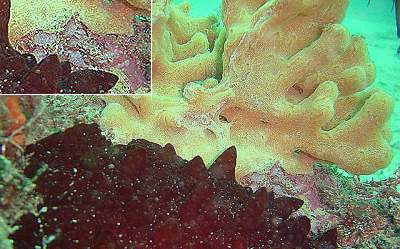
Hi Bill,
I'm so glad my message was so helpful to you. The photo I sent in one of my earlier messages shows one actually feeding, clearly showing the 'bite' marks.
Sue
snewson@shoal.net.au
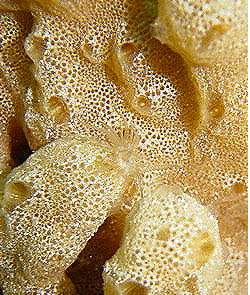
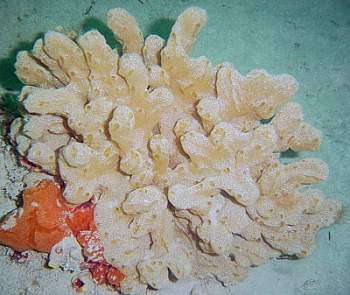
Thanks Sue,
Sorry, I missed the significance of the photo with the 'bite marks'. I have copied it here with a close-up of the 'bite mark.' At the risk of sounding like a policeman, can I ask if you actually saw it biting? As far as I know we have no record of Pleurobranchus hilli feeding, so the more 'weight' I can give your evidence the better. Basically an 'eye-witness account' is better than the circumstantial evidence of 'it was by the bite so it must have done it'.
Another point of interest is the object it is eating. It certainly looks like a sponge colony, but as far as I know, species of Pleurobranchus have never been observed feeding on sponges - their sole food seems to be ascidians. So if your Pleurobranchus is eating this colony then it either the first record of a Pleurobranchus eating a sponge, or the colony is an ascidian. Interestingly there is an ascidian - Didemnum spongoides Sluiter,1909 - which looks very like a sponge colony, and is often mistaken for one. It has not been recorded from New South Wales, but has been found in most of the rest of Australia and the tropical Indo-Pacific, so there is no real reason why it couldn't occur in Jervis Bay. The family Didemnidae, to which it belongs, has calcareous spicules in its skin so colonies can feel as rigid as a spiculate sponge colony so there is no easy way for you to determine whether it is a sponge or an ascidian in the field. My bet is that it is an ascidian, so it would be nice to get a confirmation of your feeding observation.
Best wishes,
Bill Rudman
Pleurobranchus hilli from eastern Australia
April 16, 2003
From: Sue Newson

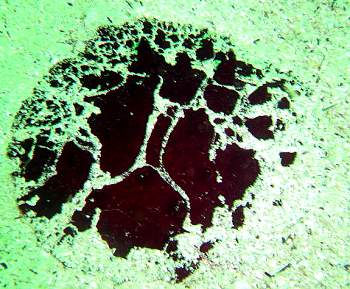
Hi Bill,
I've been browsing your site for some time now and had to send you this information and photo's. I've been working on a live-a-board dive resort, Ocean Trek, situated in Jervis Bay, New South Wales, Australia. I've spent the past 4 years exploring the many dive sites (and still haven't done them all). I first came across this pleurobranch at a site on the southern side of the bay called Murrays Sandline. It has a depth range of 5 - 15m, beginning at 5m down a slope covered in seagrasses to 9m when the sand and muck dive begin. It was on the 16 December 2000 and I came across a mating pair. I cant tell you exactly the size, but the biggest was a lot bigger than 30cm. (the only thing I can compare it to is an oval plastic laundry basket. The other one was about 1/3 the size. I had no idea what it was until I recently saw it again, then began to see it in various locations around Jervis Bay. The first resighting was on 11.02.02 at around midday. It was buried under the sand with its tubercules exposed. I uncovered it and tried to lift it at the edge and the tiny piece I was holding broke off. I saw it regularly until the 30 December 2002.
Best wishes,
Sue Newson
snewson@shoal.net.au
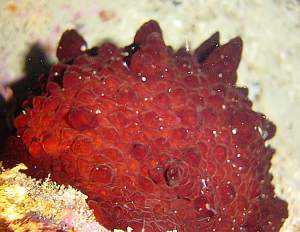
Dear Sue,
Welcome to the Forum and thanks for the contribution. This is Pleurobranchus hilli, another species of Pleurobranchus absent from the Forum before your message. Being a subtidal, sand-dwelling species it is not often encountered, and so we don't have many records of it. I suspect however that it is nowhere near as rare as out list of sightings would suggest. As you have discovered, this would appear to be one of the giants of th pleurobranch world. For those of you unfamiliar with the species, the white reticulate pattern in the above photos is formed from white sand sitting on, or adhering to, the mantle. If you run across the species quite often, it would be nice to have some idea of what it eats and what its egg ribbons look like.
We may already have an idea about its egg ribbon as I have found an earlier message from Grey McNeil from Port Stephens, which shows an animal which is most probably is this species, laying eggs. It has been languishing, rather lost, amongst the P. forskalii messages.
Best wishes,
Bill Rudman
Pleurobranchus hilli - mating
April 16, 2003
From: Sue Newson

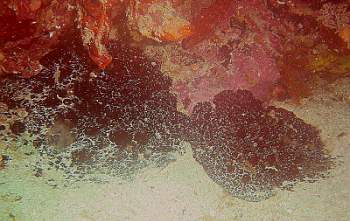
Hi Bill,
To accompany my other message, here are some shots showing Pleurobranchus hilli mating.
Best wishes,
Sue
snewson@shoal.net.au
Newson, S., 2003 (Apr 16) Pleurobranchus hilli - mating. [Message in] Sea Slug Forum. Australian Museum, Sydney. Available from http://www.seaslugforum.net/find/9670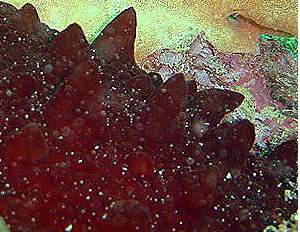
Thanks Sue,
The upper photo is quite useful as it shows the colour variation in the species. I have also included alongside a part of one of your photos showing a lateral view of the tubercles.
Best wishes,
Bill Rudman
Side gill slugs from New South Wales
July 17, 1999
From: Grey McNeil
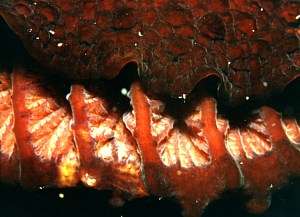
Hi Bill,
Is this a Pleurobranchus? I found them at Fly Pt Nelson Bay NSW Aust.in May 1996 at 12m.
They were about 20cm in diameter and mating. There egg mass was about 8cm wide and 2 meters long!!
Sorry about the quality but it was a bad viz night dive.
TOP: part of gill on right side.
BOTTOM LEFT: head region showing rhinophores.
BOTTOM RIGHT: Section of egg ribbon -white lines are strings of tiny eggs. [Reddish brown sacs are red alga.]
Thanks
Grey
GREYMACIND@bigpond.com.au
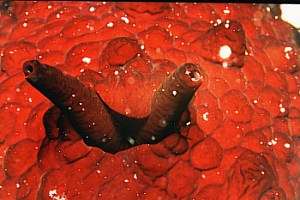
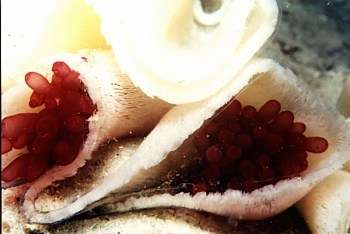
Note: identified as P. hilli - 16 April 2003
Dear Grey,
Yes it is definitely a Pleurobranchus but I am not sure of the species. At the size you mention it is possibly a big Pleurobranchus forskalii but that's only a guess. As you can see above, P. forskalii usually has distinctive white markings in the darker colour forms.
Bill Rudman.
